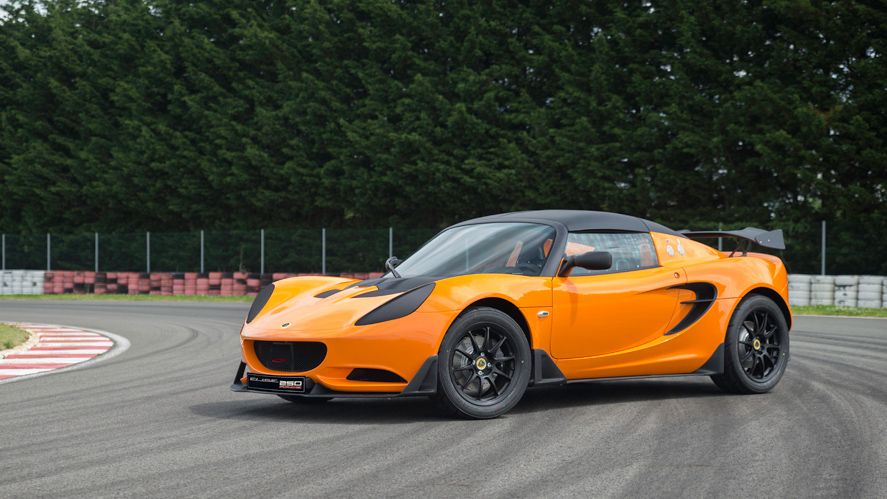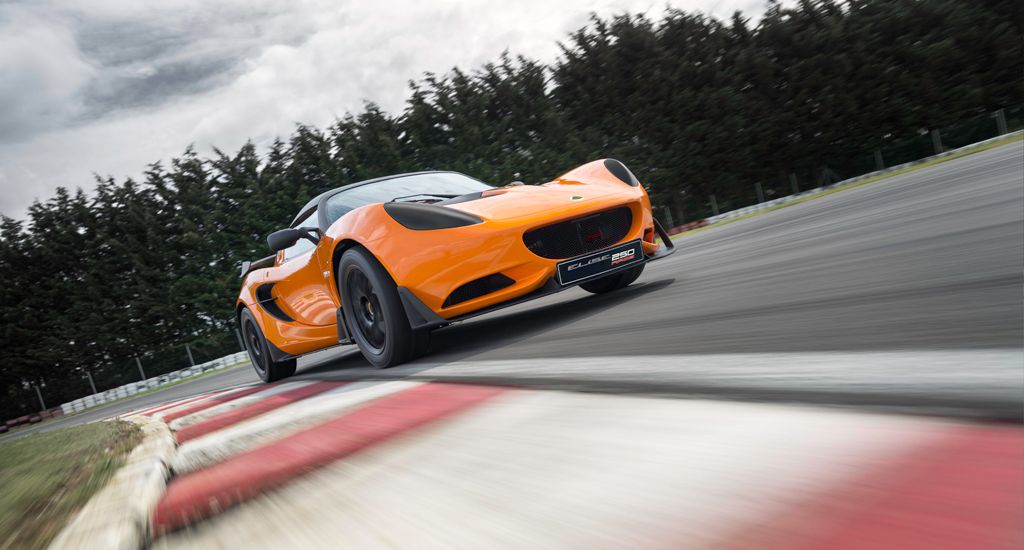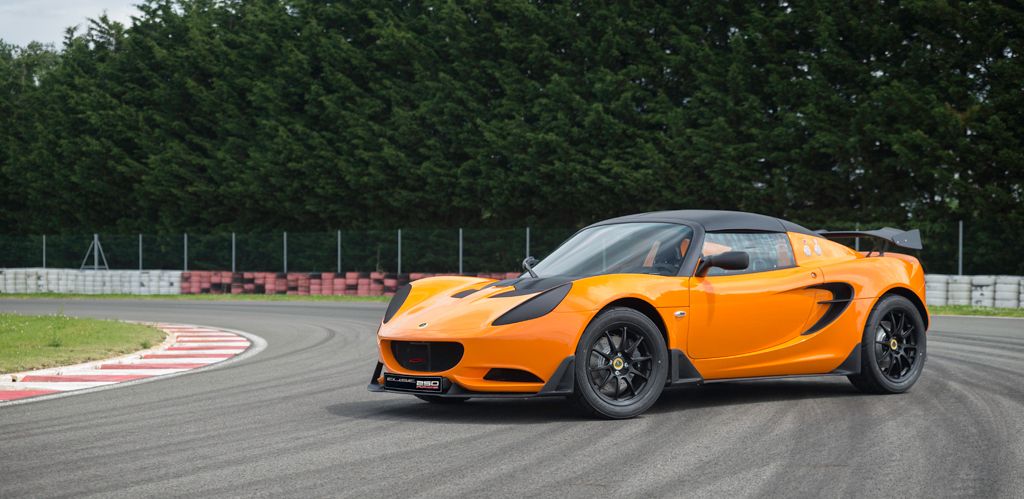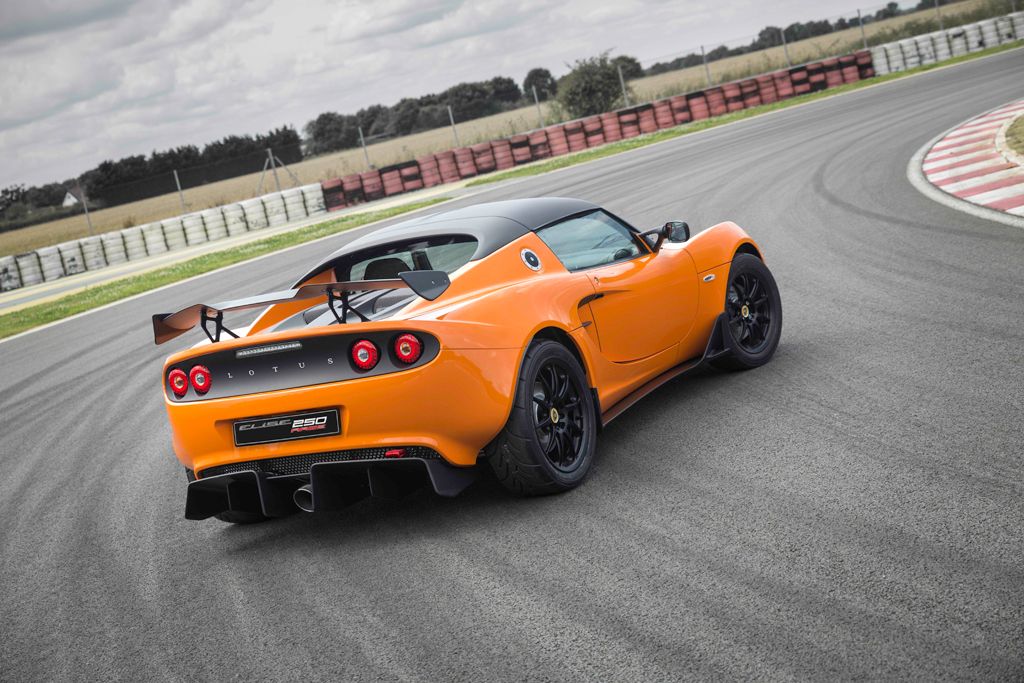Now entering its second decade in production, the Lotus Elise is simply one of the most capable speed machines on the planet, as evidenced by the numerous platform iterations (Tesla Roadster, Hennessey Venom GT, etc.) and high-spec track day specials that have sprung up over the years. Now, Lotus is offering its most hardcore track-oriented Elise to date, and it’s called the Race 250. The number is a reference to the car’s blown 1.8-liter output figures, which are complemented by a slew of standard performance options, including a race-ready interior, full aerodynamics, adjustable suspension, and a fiber-rich diet. And, as luck would have it, it’s coming to the U.S.
According to Jean-Marc Gales, CEO of Group Lotus plc., “The Elise Race 250 is the fastest, most focused Elise we’ve ever produced and, judging by what it’s capable of on track, it looks set to become a favorite with our racers around the world.”
Backing Gales’ claim is the Race 250’s 1:33.5 lap time around Lotus’ Hethel test track, a time that bests the Elise Cup 220 R by a full half-second and secures the 250’s spot as the fastest racing Elise that Lotus has ever developed.
So what exactly makes this mighty little giant slayer so darn potent? Read on for the details.
Continue reading to learn more about the Lotus Elise Race 250.
2017 Lotus Elise Race 250
- Make: Array
- Model: 2017 Lotus Elise Race 250
- Horsepower: 243
- Torque: 184
- Transmission: six-speed
- [do not use] Vehicle Model: Array
Exterior
Stylistically speaking, the Race 250 doesn’t really differ from the standard Elise. It’s still got the same forward-leaning proportions, manically grinning fascia, and over-sized fenders. However, Lotus upped the ante substantially with a full aerodynamics package that boosts the classic Elise lines to full-on GT race car mode.
Offsetting the brightly colored body panels, we find a suite of matte-black downforce generators, including a front splitter, rear diffuser, side skirts, and a rear wing. From a purely visual point of view, I think the new aero looks fantastic, transforming the fun-loving Elise into a no-nonsense weapon of velocity.
But as you might expect, the wings aren’t just for show. Their purposeful design make a real difference at speed – specifically, 66 kg (145.5 pounds) of downforce at 100 mph, and 155 kg (341.7 pounds) of downforce at the car’s 154-mph top speed.
More track focus comes with weight saving measures. The rear windscreen was replaced with plastic, while the headlights were tossed in favor of blank composite panels that look like someone was getting creative in a racing game editor. In the corners are ultra-lightweight forged alloy wheels, which are staggered with a 16-inch diameter in front and 17-inch diameter in the rear.
Finally, towing eyes are in place in front and back in case you stuff it.
Interior
We didn’t get any pictures of the Race 250’s cockpit, but according to Lotus, it sounds pretty serious.
The track goodies start with new racing buckets made from carbon fiber, which help to shave a few kilos compared to the seats in the standard Elise.
To help it pass tech inspection, the Race 250 gets an FIA-approved rollcage, plus a six-point racing harness mounted to an A-frame harness bar. There’s also a fire extinguisher, and a battery isolator.
And while you’d be crazy to call the standard Elise “plush,” I’m betting Lotus carved out any remaining vestiges of civility left over from the standard model. After all, features like electric windows, HVAC, air bags, central locking, and upholstery of any kind are simply unnecessary in a race car.
But you already knew that.
Drivetrain
Note: Engine from 2016 Lotus Elise Sport 200 shown here.
The standard Elise is equipped with a transverse-mounted 1.6-liter four-cylinder engine producing 134 horsepower and 118 pound-feet of torque. The engine sits in the middle, and sends output to the rear axle by way of a six-speed manual transmission. A sprint to 60 mph takes 6 seconds dead, while top speed is 127 mph.
By comparison, the Race 250 is similar, but much, much more potent. The mid-engine, RWD layout is retained, but the 1.6-liter powerplant is replaced by a supercharged 1.8-liter four-pot laying down 243 horsepower at 7,200 rpm and 250 Nm (184 pound-feet) of torque at 3,500 rpm.
That’s a sizable jump, and while Lotus has yet to divulge official acceleration figures, I’d wager the 0-to-60 mph sprint takes less than 4 seconds to complete – 3.7 seconds feels about right.
As previously stated, top speed is rated at 154 mph.
Chassis And Handling
Of course, if you know anything about the Elise, you know it’s a car that’s focused on corners, not the straights that string them together.
Developed in the automaker’s well-titled “Lightweight Laboratory,” the Race 250 trims the fat to an obsessive degree. It all starts with the hugely popular Elise chassis, which is made from aluminum and held together with epoxy adhesives for low bulk and high torsional rigidity. On its own, the chassis weighs a mere 68 kg (149.9 pounds).
Next, Lotus performed its usual nitpicking to shave off precious kilos. For example, the battery is a lithium-ion unit that cuts 10 kg (22 pounds), while the carbon-fiber seats cut 6 kg (13.2 pounds).
If you want the lightest Elise Race 250 available (and you do), it’s advised you grab the optional Carbon Aero Pack, which incorporates carbon fiber replacements for the front splitter, rear diffuser, side skirts, and rear wing. The result is yet another 10 kg left off the scales.
With all the right options ticked, the Elise Race 250 boasts a dry weight of just 1,984 pounds. Not bad when you consider the larger, supercharged engine mounted behind the cockpit.
Managing the heft is a double wishbone suspension set-up that provides “optimum body and roll control, but not at the expense of composure or turn in and without sacrificing high-speed stability.”
I’ll translate – that’s what you want.
One-way adjustable dampers from Nitron offer some tunability, and come paired with coaxial coil springs from Eibach. There’s also an adjustable front anti-roll bar.
Making it stop are high-performance brake pads, clamped by two-piston front calipers from AP Racing and single-piston rear calipers from Brembo. ABS is retained.
The factory rubber is Yokohama’s AO48 compound, sized 195/50R16 in front and 225/45R17 in back.
Prices
Stateside customers looking to get their hands on the fastest racing Elise that Lotus has ever produced should be prepared to dig deep, as pricing starts at a lofty $76,200.
Meanwhile, U.K. customers can have one for 44,583 pounds (or 53,500 pounds if you include VAT at 20 percent).
Competition
Ariel Atom 3
Lotus has made a name for itself by producing cars that are simple and lightweight. The Atom is a racer that takes that philosophy to an extreme, offering little more than four wheels, an engine, and some metal bits to connect it all. Ariel offers a wide selection of models, but the best match for the Elise Race 250 would be the Atom 3, which is equipped with 230 horsepower, a six-speed gearbox, and 1,350 pounds of curb weight. Pricing starts at $64,500.
Read the full review here.
Caterham Seven 620S
Some designs are so good, they don’t really need to be changed. The Elise is one example, while the Caterham Seven is another. Going head-to-head with the Elise Race 250 is the Seven 620S, which comes packing with 310 supercharged horsepower, a five-speed manual gearbox, and less than 1,400 pounds of curb weight. Pricing starts at 44,995 pounds ($59,367 at current exchange rates, 07/27/2016).
Read the full review here.
Conclusion
According to Lotus, “The new Elise Race 250 benefits from the continuous design philosophy of Lotus and its perpetual quest to evolve all constituent parts, lightening and optimizing them.”
You know – “Simplify, then add lightness.”
By all accounts, the Elise Race 250 stays true to Chapman’s brilliant maxim, and thank goodness for that – the car arrives a half century since the Lotus team relocated to Hethel, Norfolk, the location where it refined all of its performance machines, including its Grand Prix cars.
Appropriately, the Elise Race 250 can be used in a variety of race series around the world, and Lotus says it applied its vast motorsport experience in its creation.
From that perspective, $75,000 is peanuts for the knowledge gained from seven World Constructors’ Championships and six World Drivers’ Championships.
Nonetheless, I have a hard time recommending the Race 250.
The performance, the looks, the out-of-the-box race-readiness… that’s all great. But at the same time, the standard Elise is almost as good – you get the same chassis, plenty of power, and almost all the fun, all for significantly less outlay than the Race 250.
That said, if you absolutely must have the fastest, then I suppose the choice is already made.








